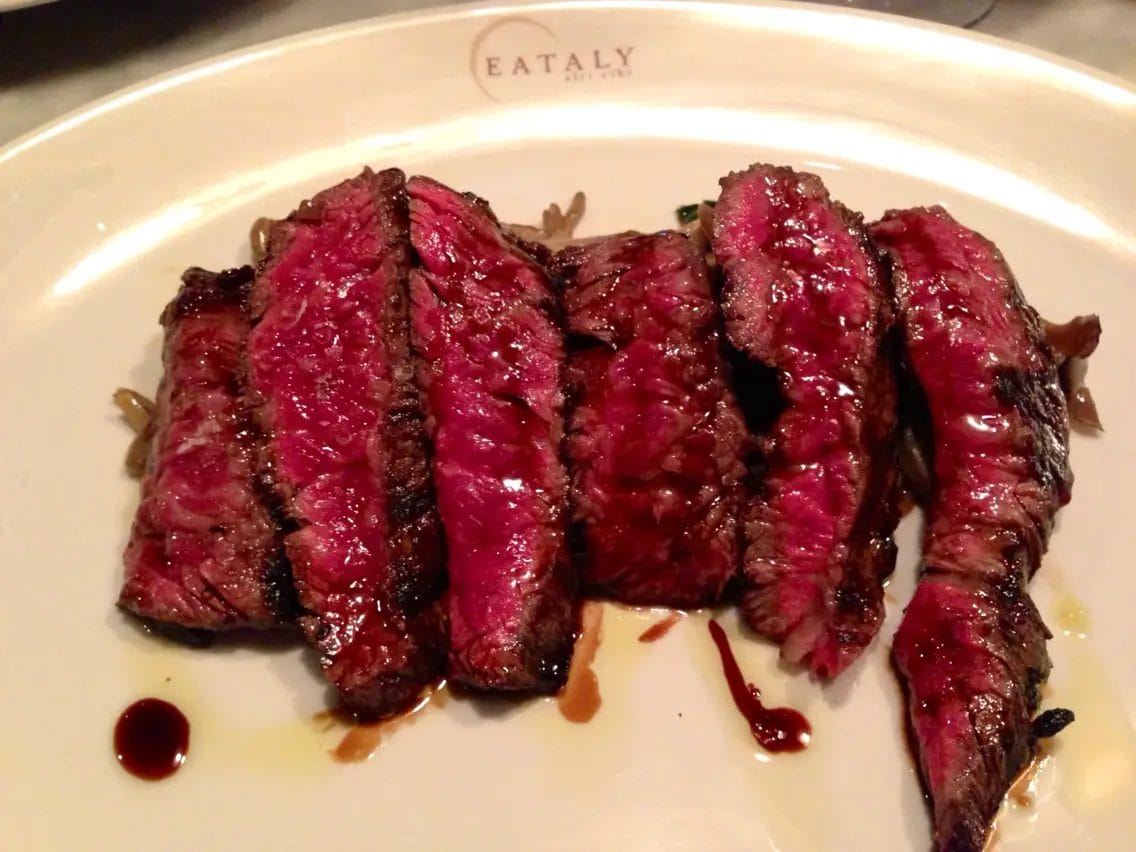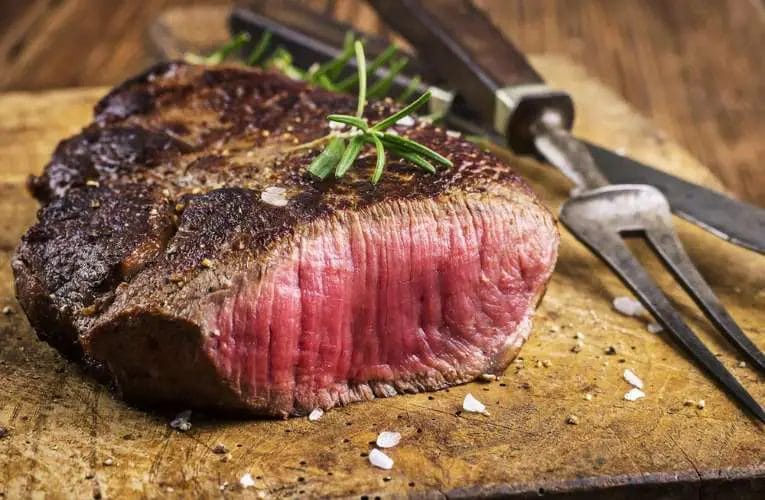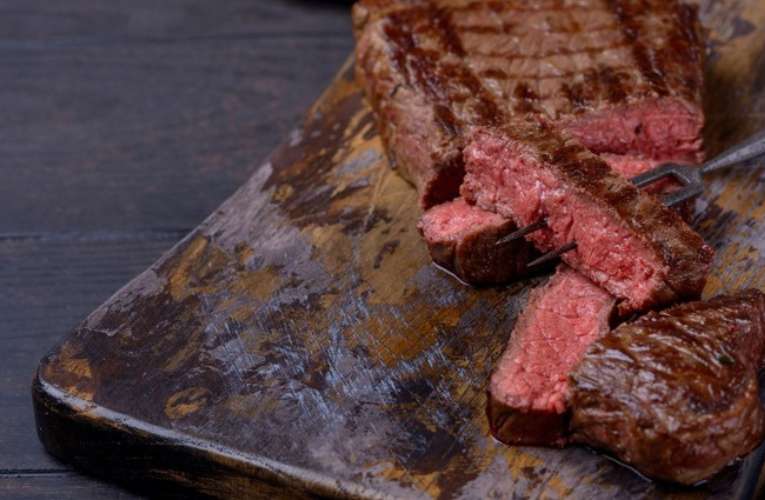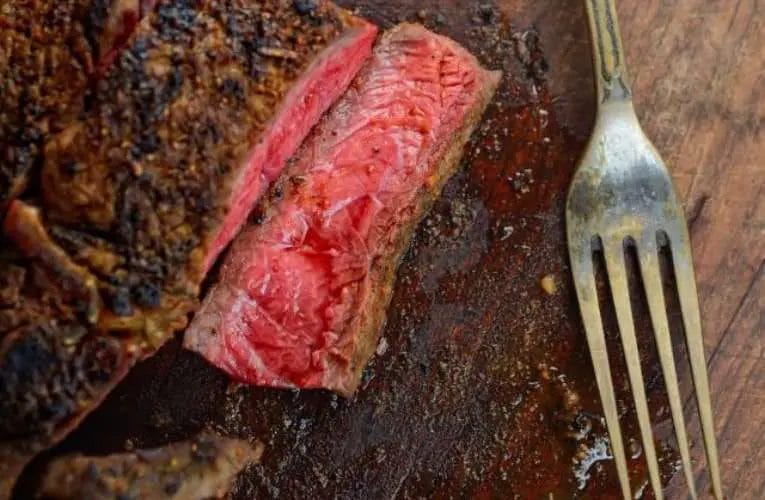A medium rare steak is not bloody but instead cooked to a juicy perfection with a slight hint of pink in the center.
The term “bloody” is a common misconception as the red juices present in a cooked steak are actually a combination of water and myoglobin, a protein found in muscles, not blood.
This cooking style allows for a tender and flavorful steak, retaining its natural juices and ensuring a delightful dining experience.

The Perfect Medium Rare Steak: A Delightfully Juicy Option
There is something truly satisfying about biting into a perfectly cooked steak. The juicy tenderness, the flavorful sear on the outside, and the rich aroma make it a true culinary delight.
While there are many ways to cook a steak, one method that stands out for its delectable results is cooking it to a medium rare temperature. In this section, we will explore the art of cooking the perfect medium rare steak and why it is such a popular choice among steak enthusiasts.
What is Medium Rare?
Before we dive into the details of cooking a medium rare steak, let’s first understand what it means. Medium rare refers to the internal temperature of the steak, which typically ranges between 130°F to 135°F (54°C to 57°C).
At this temperature, the steak is cooked to perfection – it has a warm pink center with a slightly seared exterior. This level of doneness allows the steak to retain its natural juices, resulting in a tender and succulent piece of meat.
The Benefits of Medium Rare
So why do so many steak connoisseurs prefer their steaks cooked to a medium rare temperature? There are several reasons:
- Juiciness: The medium rare cooking method allows the steak to retain its natural juices, resulting in a moist and tender eating experience. The higher temperatures of well-done steaks can cause the meat to dry out, making it less enjoyable.
- Flavor: Cooking a steak to medium rare enhances its flavor profile. The sear on the outside caramelizes the surface, creating a savory crust, while the pink center adds a depth of flavor that is both bold and delicate.
- Tenderness: A medium rare steak is the perfect balance of tenderness and texture. The meat is soft and easy to cut, while still offering a slight resistance that adds to the overall eating experience.
Cooking the Perfect Medium Rare Steak
Now that we understand the appeal of a medium rare steak, let’s explore how to cook it to perfection:
- Choose the right cut: Start by selecting a high-quality cut of steak that is well-marbled. Popular choices for medium rare steaks include ribeye, filet mignon, and striploin.
- Preparation: Allow the steak to come to room temperature before cooking. Season generously with salt and pepper or your favorite steak rub.
- Preheat the grill or pan: Heat your grill or pan over high heat to achieve a good sear on the steak.
- Cooking time: Place the steak on the grill or pan and cook for approximately 3-4 minutes per side for a 1-inch thick steak. Use a meat thermometer to ensure the internal temperature reaches 130°F to 135°F (54°C to 57°C).
- Resting: Allow the steak to rest for a few minutes before slicing. This allows the juices to redistribute, resulting in a more flavorful and tender steak.
Remember, cooking times may vary depending on the thickness of the steak and your desired level of doneness. It’s always a good idea to use a meat thermometer to ensure the steak reaches the perfect medium rare temperature.
Pairing with Delicious Sides
A perfectly cooked medium rare steak pairs wonderfully with a variety of delicious sides. Consider serving it with roasted vegetables, a classic baked potato, or a fresh salad.
The robust flavors of the steak complement the freshness and textures of these accompaniments, creating a well-rounded and satisfying meal.

Achieving the Ideal Doneness: Exploring the Beauty of Medium Rare Steak
Steak lovers around the world will agree that achieving the perfect doneness is the key to unlocking the true beauty and flavor of a steak. While some may prefer a well-done steak, others believe that medium rare is the pinnacle of steak perfection.
In this section, we will delve into the art of cooking a medium rare steak and explore the reasons why it has become such a beloved choice among steak enthusiasts.
The Definition of Medium Rare
To truly appreciate the allure of a medium rare steak, it’s important to understand what this doneness level entails. Generally, a medium rare steak is cooked to an internal temperature of around 135-140°F (57-60°C).
At this point, the steak is cooked enough to enhance its flavors and textures while retaining a juicy and tender interior. The exterior should have a nicely seared crust, adding an element of caramelization and depth of flavor.
The Magic of Maillard Reaction
One of the key reasons why medium rare steaks are highly sought after is the magic of the Maillard reaction.
This reaction occurs when the high heat of cooking causes the amino acids and sugars in the steak to undergo a complex chemical reaction, resulting in the development of rich flavors and aromas.
The Maillard reaction is responsible for that mouthwatering sear on the exterior of a medium rare steak.
Retaining Juiciness and Tenderness
When steak is cooked beyond medium rare, it tends to lose its juiciness and tenderness. Higher heat and longer cooking times cause the proteins in the meat to denature, resulting in a drier and tougher texture.
By cooking a steak to medium rare, you can preserve the natural juices within the meat and maintain a delightful tenderness that melts in your mouth.
Enhancing the Flavor Profile
Medium rare steaks offer a unique balance of flavors that is often praised by steak aficionados. The combination of a lightly charred exterior and a juicy, pink center creates a symphony of flavors that is both savory and satisfying.
The natural flavors of the beef are intensified without overpowering the palate, allowing the true essence of the steak to shine through.
Mastering the Cooking Process
To achieve the perfect medium rare steak, it is essential to master the cooking process. Start by selecting a high-quality cut of steak, such as a ribeye or filet mignon, with good marbling for maximum flavor. Preheat your grill or skillet to high heat and season the steak generously with salt and pepper.
Place the steak on the hot surface and sear it for a few minutes on each side to develop a beautiful crust. Then, reduce the heat to medium and continue cooking until the desired internal temperature is reached.
If you prefer a more visual reference, you can use a meat thermometer to ensure precision. For medium rare, aim for an internal temperature of 135-140°F (57-60°C).
Once the steak reaches the desired temperature, remove it from the heat and let it rest for a few minutes to allow the juices to redistribute. This resting period will further enhance the tenderness and juiciness of the steak.
Pairing Medium Rare Steak with Complementary Flavors
The beauty of a medium rare steak extends beyond its cooking perfection. Pairing it with complementary flavors can elevate the dining experience to new heights.
Consider serving your medium rare steak with a side of roasted vegetables, a creamy potato gratin, or a tangy chimichurri sauce. The combination of textures, flavors, and contrasting elements will create a harmonious balance that pleases the palate.

The Art of Cooking Medium Rare Steak: Tips and Techniques
Medium rare steak is a culinary delight that many meat lovers crave. Achieving the perfect medium rare steak requires precision and attention to detail.
In this section, we will explore the art of cooking medium rare steak, providing you with tips and techniques to help you master this delicious cooking method.
1. Choosing the Right Cut of Meat
The first step to cooking a medium rare steak is selecting the right cut of meat. Different cuts have varying levels of marbling and fat content, which can affect the taste and tenderness of the steak. Some popular cuts for cooking medium rare steak include ribeye, filet mignon, and New York strip.
When choosing your steak, look for cuts that have a good amount of marbling, as this will enhance the flavor and juiciness. Marbling refers to the thin white streaks of fat that are evenly distributed throughout the meat. The fat melts during cooking, adding moisture and richness to the steak.
2. Preparing the Steak
Before cooking your medium rare steak, it is important to let it come to room temperature. This allows for more even cooking throughout the steak. Take the steak out of the refrigerator and let it sit at room temperature for about 30 minutes before cooking.
Seasoning the steak is another crucial step in preparing it for cooking. Generously season both sides of the steak with salt and pepper, or any other desired seasonings. This helps to enhance the natural flavors of the meat.
3. Cooking Techniques
There are several cooking techniques you can use to achieve a perfect medium rare steak. Two popular methods include pan-searing and grilling.
Pan-searing: Heat a cast iron skillet or heavy-bottomed pan over high heat. Add a small amount of oil or butter to the pan and let it heat up until shimmering. Place the steak in the pan and let it sear for a few minutes on each side, until a golden brown crust forms. Then, transfer the pan to a preheated oven and continue cooking until the desired doneness is reached.
Grilling: Preheat your grill to medium-high heat. Place the steak on the grill and cook for a few minutes on each side, turning once, until grill marks are formed. Then, move the steak to a cooler part of the grill and continue cooking until the desired level of doneness is achieved.
4. Checking for Doneness
Checking the doneness of your steak is an essential step to ensure it is cooked to medium rare perfection. There are several methods you can use to determine the level of doneness:
- Using a meat thermometer: Insert a meat thermometer into the thickest part of the steak. For medium rare, the internal temperature should read around 130-135°F (55-57°C).
- Touch test: Gently press the center of the steak with your finger. If it feels soft and slightly springy, it is likely medium rare.
- Visual cues: Cut into the steak and examine the color. A properly cooked medium rare steak should have a warm pink center.
5. Resting and Serving
Resting the steak is a crucial step that should not be overlooked. After cooking, remove the steak from the heat source and let it rest for about 5-10 minutes. This allows the juices to redistribute throughout the meat, resulting in a more flavorful and tender steak.
Once the steak has rested, it is ready to be served. Slice the steak against the grain and arrange it on a serving platter. Medium rare steak pairs well with a variety of side dishes, such as roasted vegetables, mashed potatoes, or a fresh salad.
Savoring the Succulence: Why Medium Rare Steak is Worth the Try
When it comes to cooking steak, there are various levels of doneness to choose from. From well-done to rare, each level offers a unique taste and texture. However, one level that stands out and is worth a try is medium rare.
In this section, we will explore why medium rare steak is a culinary delight that should not be overlooked.
1. Juicy and Tender
One of the key reasons to opt for a medium rare steak is the juicy and tender texture it offers. When cooked to medium rare, the steak retains its moisture, resulting in a succulent and flavorful bite. The heat from cooking seals in the juices while still allowing the center to remain tender and moist.
2. Enhanced Flavor
Medium rare steak provides a perfect balance between a charred outer crust and a pink, slightly warm center. This level of doneness allows the natural flavors of the meat to shine through.
The Maillard reaction, a chemical reaction that occurs during cooking, creates a depth of flavor that enhances the overall taste profile of the steak.
3. Improved Nutritional Value
Contrary to popular belief, medium rare steak can be a healthier option compared to well-done steak. Overcooking the meat for an extended period of time can lead to the formation of harmful compounds.
By opting for medium rare, you can reduce the formation of these compounds while still enjoying a delicious meal.
4. Chefs’ Preferred Choice
Many professional chefs and culinary experts prefer to cook steak to medium rare, and for good reason.
They understand that this level of doneness allows the meat to showcase its natural flavors and tenderness. Chefs often consider medium rare to be the best way to experience the true essence of a quality cut of beef.
5. Versatile Pairings
Medium rare steak pairs well with a variety of flavors and accompaniments. Whether you prefer a bold red wine, a creamy mushroom sauce, or a zesty chimichurri, the tender texture and enhanced flavor of medium rare steak can complement a range of seasonings and sauces.

Beyond the Bloody Appearance: Unveiling the Flavorful Magic of Medium Rare Steak
When it comes to cooking steak, there are a plethora of options to choose from. From well done to rare, each level of doneness offers a unique taste and texture.
However, one particular level that stands out for its flavorful magic is medium rare. In this section, we will delve into the world of medium rare steak and explore why it is a popular choice among steak enthusiasts.
The Art of Cooking Medium Rare Steak
Medium rare steak is cooked to an internal temperature of 135°F to 145°F (57°C to 63°C), resulting in a warm red center with a slightly pink exterior. This level of doneness allows the natural flavors and juices of the steak to remain intact, creating a tender and succulent eating experience.
Achieving the perfect medium rare steak requires precision and attention to detail in the cooking process.
Flavor, Texture, and Juiciness
The magic of medium rare steak lies in its balance of flavors, texture, and juiciness. The slightly pink center signifies a steak cooked to perfection, where the meat remains tender and succulent.
The seared exterior creates a flavorful crust, while the internal temperature ensures that the steak remains juicy and full of flavor.
The medium rare doneness allows the natural flavors of the beef to shine through, giving you a true taste of the meat itself. Whether you prefer a ribeye, strip steak, or tenderloin, medium rare cooking brings out the best in any cut, enhancing its inherent flavors and tenderness.
The Benefits of Medium Rare
Medium rare steak offers several benefits that contribute to its popularity:
- Tenderness: Cooking steak to medium rare allows the muscle fibers to retain their moisture, resulting in a tender and melt-in-your-mouth texture.
- Juiciness: The internal temperature of medium rare steak ensures that the meat retains its natural juices, keeping each bite moist and flavorful.
- Flavor: By not cooking the steak to well done, the natural flavors of the beef are preserved, offering a more intense and satisfying taste experience.
- Versatility: Medium rare steak pairs well with a variety of sauces, seasonings, and accompaniments, allowing for endless culinary possibilities.
Expert Tips for Cooking Medium Rare Steak
If you’re ready to embark on a medium rare steak cooking adventure, here are some expert tips to help you achieve the perfect result:
- Start with a high-quality cut of steak to ensure optimal flavor and tenderness.
- Preheat your grill or pan to a high temperature to create a seared crust on the steak.
- Season the steak with salt and pepper or your favorite rub before cooking.
- Cook the steak for a few minutes on each side, depending on the thickness, until it reaches the desired internal temperature.
- Allow the steak to rest for a few minutes after cooking to allow the juices to redistribute and enhance the flavor.

FAQs
Is a medium rare steak bloody?
A medium rare steak may appear slightly pink in the center, but it is not considered “bloody.” The pink color comes from a protein called myoglobin, not blood. Cooking a steak to medium rare allows it to retain more juices and tenderness, resulting in a flavorful and moist steak.
Conclusion:
In conclusion, the question of whether a medium rare steak is bloody is a common misconception. While the center of a medium rare steak may appear slightly pink or red, it is not blood.
The juice that is released is a combination of water and myoglobin, a protein found in muscle tissue. This is perfectly safe to consume and is often considered the ideal level of doneness for steak lovers.
When cooking a steak to medium rare, the exterior gets seared, creating a flavorful crust, while the interior remains juicy and tender. This balance of texture and taste is what makes medium rare steaks highly sought after by steak enthusiasts.
So, next time you order a medium rare steak, rest assured that it is not bloody but a perfectly cooked delicacy.

